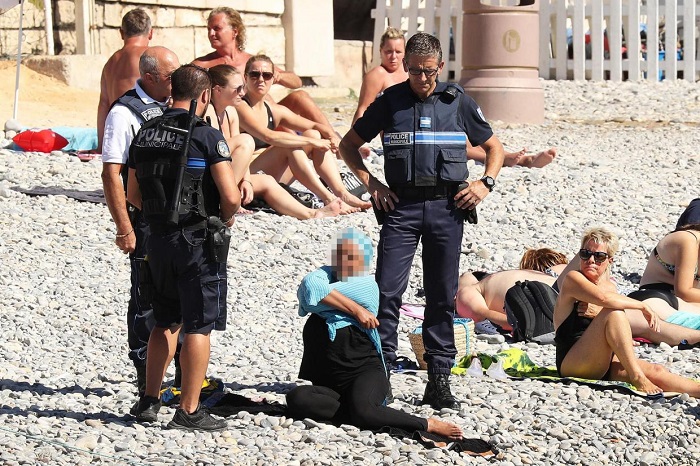Images of a Muslim woman being forced to remove some of her clothing by armed male police officers at a beach in Nice went viral last week, sparking global outrage. The officers were enforcing a French ban on the “burkini” – a full-body swimsuit that allows women to swim with the majority of their skin covered.
On Friday, France’s highest court ruled that the burkini ban was illegal. Despite the ruling, police have continued to target women with modest swimwear along the French Riviera, Nice and Côte d’Azur. Several mayors have vowed to uphold the ban, with the support of Prime Minister Manuel Valls.
But why is a western European country – that prides itself on being liberal-minded and democratic – telling women what to wear? Officials claimed that the burkini goes against the French value of laïcité (secularism). A Nice court ruled that banning the burkini was “necessary” to fight terrorism – without explaining how skin-concealing swimwear posed a threat to France’s national security.
The French fixation with what Muslim women wear is not about secularism or security. It originates from French colonialism in North Africa, particularly Algeria – where so many French Muslims have their roots.
The veil was as much a French obsession then as it is now. For instance, a poster distributed in Algeria in 1958 shows four women, three wearing the veil, covering their faces. The last – and most prominent – beams with an uncovered face. “Aren’t you pretty then?” the poster asks. It then orders them: “Unveil yourselves!” Public burnings of headscarves by “liberated” Algerian women were regularly organised by their French colonial masters.
Frantz Fanon’s essay ‘Algeria Unveiled’ was written a year later. In it, Fanon argued that the French believed that Algerian society’s capacity for resistance could be destroyed through women. For many Algerians, the veil helped preserve their national existence. For the French colonisers, unveiling Algerian women symbolised the capture of the country.
Between 1957 and 1960, the French army forcibly transferred two million Algerians from their villages in the mountains to internment camps near the city. They were photographed by army photographer, Marc Garanger, so that identity cards could be produced. After seeing the photos, Garanger’s commander ordered that all the women be photographed without their veils.
Garanger recalled that the women were so humiliated about revealing their face and hair to anyone outside their family, that they stood before him “as if they were naked.” There are violent parallels between these 50-year old photographs and the ones that emerged last week: French men with guns ordering Muslim women to undress.
France continues to police Muslim women’s bodies. Since 1989, hundreds of Muslim female students have been suspended, and even expelled, for refusing to remove their headscarves at schools. By 2004, the headscarf was banned completely at French public schools. In 2010, a bill was passed banning the covering of the face, denying Muslim women the right to wear a veil in public. In 2013, a nursery school assistant was fired for refusing to remove her headscarf. Hundreds of similar cases of workplace discrimination were documented by French Muslim rights groups.
Throughout it all, mainstream French feminists remained silent, tacitly approving the French government’s actions. Yet, these same feminists, and other champions of women’s rights, denounced the burkini ban. Muslim women have as much right to wear a face veil or headscarf, as they do the burkini. You cannot cherry pick which pieces of clothing Muslim women have the right to wear.
France’s ban on the veil, headscarf and other forms of Muslim women’s dress is not laïcité, liberte egalite, or fraternite. It is institutionalized Islamophobia and racism. The bodies of Muslim women continue to be the battlefield on which France demonstrates its cultural dominance.
Side-bar: Secularism
Laïcité is the French term for secularism. Article 1 of the 1905 French law on the Separation of the Churches and the State ensures “freedom of conscience” and “the free exercise of religion”. French secularism initially sought to ensure religious diversity in public and private, but it also protected the individual’s freedom to not to have to see others express their religion.
For nearly a century laïcité worked , ensuring sufficient public space for Catholics, Protestants, and Jews. The 1980’s and 1990’s brought a growing number of Muslim North African immigrants to France. A different conflict between the French state and established religion emerged.
Symbolic of this new tension was a series of battles in the late 1980’s over the use of headscarves by Muslim girls at public schools. By 2004, the French governments had banned all signs of religious faith including Jewish yarmulkes and Sikh turbans. It was clear, however, that the primary target of the law was the hijab. In 2010, face veils were outlawed.
The once-straightforward guarantee of “free exercise of religious faiths” has been corrupted by right-wing politicians, and laïcité is used as an excuse to express Islamophobic positions.
It is this fundamentalist version of laïcité that enables armed police officers to force a woman to change her clothes, or fine others for failing to wear “an outfit respecting good morals and secularism.”
Suraya Dadoo has been a researcher with Media Review Network for over 10 years. She focuses on the impact of the Zionist occupation on Palestinian media, education, healthcare, and family life. She holds a Masters degree in Sociology from Rhodes University.






 WhatsApp us
WhatsApp us 

